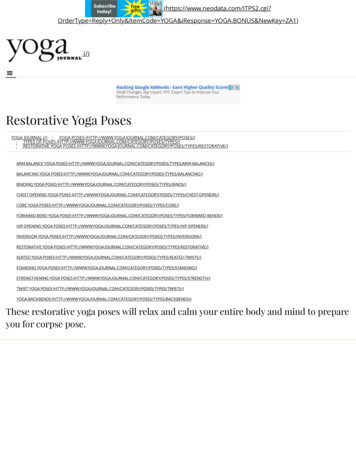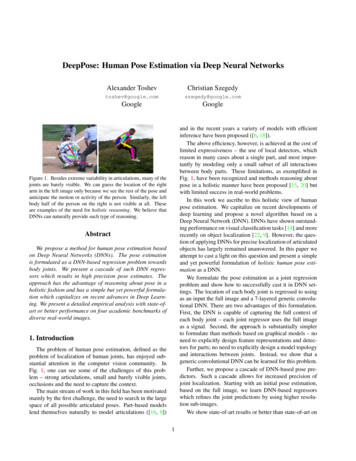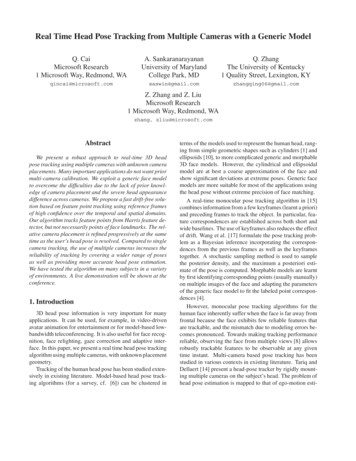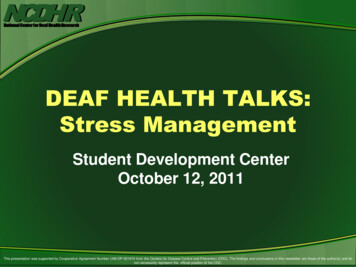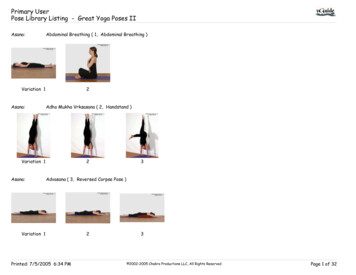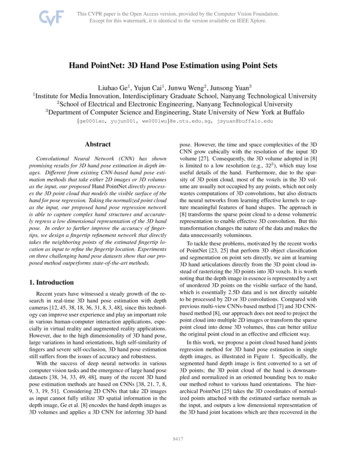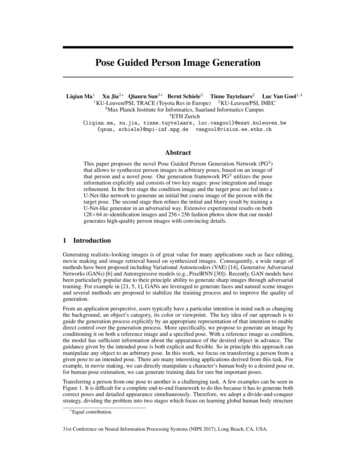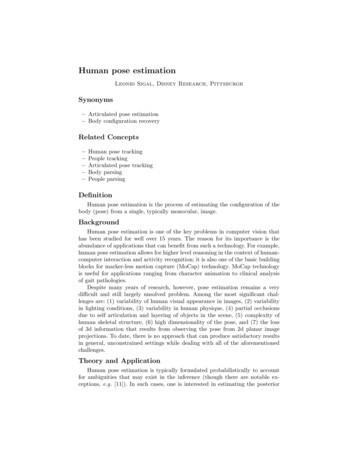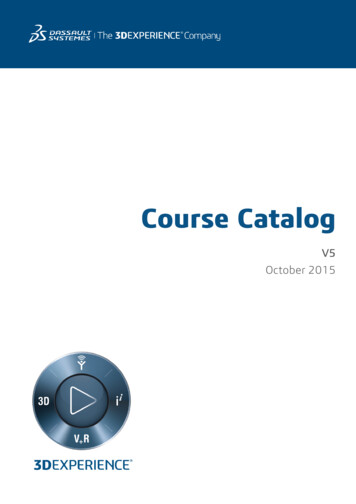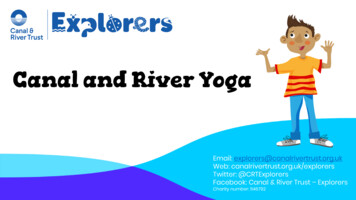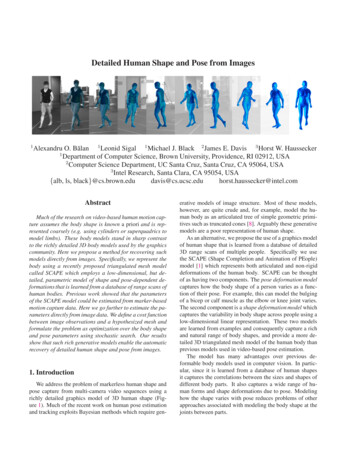
Transcription
Detailed Human Shape and Pose from Images1Alexandru O. Bălan 1Leonid Sigal 1 Michael J. Black 2 James E. Davis 3 Horst W. Haussecker1Department of Computer Science, Brown University, Providence, RI 02912, USA2Computer Science Department, UC Santa Cruz, Santa Cruz, CA 95064, USA3Intel Research, Santa Clara, CA 95054, USA{alb, ls, er@intel.comAbstractMuch of the research on video-based human motion capture assumes the body shape is known a priori and is represented coarsely (e.g. using cylinders or superquadrics tomodel limbs). These body models stand in sharp contrastto the richly detailed 3D body models used by the graphicscommunity. Here we propose a method for recovering suchmodels directly from images. Specifically, we represent thebody using a recently proposed triangulated mesh modelcalled SCAPE which employs a low-dimensional, but detailed, parametric model of shape and pose-dependent deformations that is learned from a database of range scans ofhuman bodies. Previous work showed that the parametersof the SCAPE model could be estimated from marker-basedmotion capture data. Here we go further to estimate the parameters directly from image data. We define a cost functionbetween image observations and a hypothesized mesh andformulate the problem as optimization over the body shapeand pose parameters using stochastic search. Our resultsshow that such rich generative models enable the automaticrecovery of detailed human shape and pose from images.1. IntroductionWe address the problem of markerless human shape andpose capture from multi-camera video sequences using arichly detailed graphics model of 3D human shape (Figure 1). Much of the recent work on human pose estimationand tracking exploits Bayesian methods which require gen-erative models of image structure. Most of these models,however, are quite crude and, for example, model the human body as an articulated tree of simple geometric primitives such as truncated cones [8]. Arguably these generativemodels are a poor representation of human shape.As an alternative, we propose the use of a graphics modelof human shape that is learned from a database of detailed3D range scans of multiple people. Specifically we usethe SCAPE (Shape Completion and Animation of PEople)model [1] which represents both articulated and non-rigiddeformations of the human body. SCAPE can be thoughtof as having two components. The pose deformation modelcaptures how the body shape of a person varies as a function of their pose. For example, this can model the bulgingof a bicep or calf muscle as the elbow or knee joint varies.The second component is a shape deformation model whichcaptures the variability in body shape across people using alow-dimensional linear representation. These two modelsare learned from examples and consequently capture a richand natural range of body shapes, and provide a more detailed 3D triangulated mesh model of the human body thanprevious models used in video-based pose estimation.The model has many advantages over previous deformable body models used in computer vision. In particular, since it is learned from a database of human shapesit captures the correlations between the sizes and shapes ofdifferent body parts. It also captures a wide range of human forms and shape deformations due to pose. Modelinghow the shape varies with pose reduces problems of otherapproaches associated with modeling the body shape at thejoints between parts.
2. Related WorkFigure 1. SCAPE from images. Detailed 3D shape and pose of ahuman body is directly estimated from multi-camera image data.Several recovered poses from an image sequence of a walking subject are shown.While recent work in the machine vision community hasfocused on recovering human kinematics from video, weargue that there are many motivations for recovering shapesimultaneously. For example, anthropomorphic measurements can be taken directly from the recovered body modeland may be useful for surveillance and medical applications. For some graphics applications, having direct accessto the shape model for a particular subject removes an additional step of mapping kinematic motions to 3D models.Our current implementation estimates the parameters ofthe body model using image silhouettes computed frommultiple calibrated cameras (typically 3-4). The learnedmodel provides strong constraints on the possible recovered shape of the body which means that pose/shape estimation is robust to errors in the recovered silhouettes. Ourgenerative model predicts silhouettes in each camera viewgiven the pose/shape parameters of the model. A fairly standard Chamfer distance measure is used to define an imagelikelihood and optimization of the pose/shape parametersis performed using a stochastic search technique related toannealed particle filtering [7, 8]. Our results show that theSCAPE model better explains the image evidence than doesa more traditional coarse body model.We provide an automated method for recovering posethroughout an image sequence by using body models withvarious levels of complexity and abstraction. Here we exploit previous work on 3D human tracking using simplified body models. In particular, we take the approach ofDeutscher and Reid [8] which uses anneal particle filtering to track an articulated body model in which the limbsare approximated by simple cylinders or truncated cones.This automated tracking method provides an initializationfor the full SCAPE model optimization. By providing areasonable starting pose, it makes optimization of the fairlyhigh-dimensional shape and pose space practical.Results are presented for multiple subjects (none presentin the SCAPE training data) in various poses.We exploit the SCAPE model of human shape and posedeformation [1] but go beyond previous work to estimatethe parameters of the model directly from image data. Previous work [1] estimated the parameters of the model froma sparse set of 56 markers attached to the body. The 3D locations of the markers were determined using a commercialmotion capture system and provided constraints on the bodyshape. Pose and shape parameters were estimated such thatthe reconstructed body was constrained to lie inside themeasured marker locations. This prior work assumed thata 3D scan of the body was available. This scan was used toplace the markers in correspondence with the surface modelof the subject.We go beyond the original SCAPE paper to estimate thepose and shape of a person directly from image measurements. This has several advantages. In particular, videobased shape and pose capture does not require markers to beplaced on the body. Additionally, images provide a richersource of information than a sparse set of markers and henceprovide stronger constraints on the recovered model. Furthermore, we show shape recovery from multi-camera images for subjects not present in the shape training set.Previous methods have established the feasibility of estimating 3D human shape and pose directly from image databut have all suffered from limited realism in the 3D bodymodels employed. A variety of simplified body modelshave been used for articulated human body pose estimationand tracking including cylinders or truncated cones (e.g.[8]) and various deformable models such as superquadrics[9, 14, 20] and free-form surface patches [17]. These models do not fit the body shape well, particularly at the jointsand were typically built by hand [14] or estimated in acalibration phase prior to tracking [9, 17, 20]. Detailedbut fixed, person-specific, body models have been acquiredfrom range scans and used for tracking [6] by fitting them tovoxel representations; this approach did not model the bodyat the joints.Kakadiaris and Metaxas used generic deformable models to estimate 3D human shape from silhouette contourstaken from multiple camera views [11] and tracked theseshapes over multiple frames [12]. Their approach involveda 2-stage process of first fitting the 3D shape and then tracking it. In contrast, pose and shape estimation are performedsimultaneously in our method. Their experiments focusedon upper-body tracking in simplified imaging environmentsin which near-perfect background subtraction results couldbe obtained.In related work Plänkers and Fua [15] defined a “soft”body model using 3D Gaussian blobs arranged along anarticulated skeletal body structure. The relative shapesof these “metaballs” were defined a priori and were thenscaled for each limb based on an estimated length and width
parameter for that limb. Left and right limbs were constrained to have the same measurements. The surface ofthe body model was then defined implicitly as a level surface and an iterative optimization method was proposed tofit each limb segment to silhouette and stereo data. Mostexperiments used only upper body motion with simplifiedimaging environments, though some limited results on fullbody tracking were reported in [16].Also closely related to the above methods is the work ofHilton et al. [10] who used a VRML body model. Theirapproach required the subject to stand in a known pose forthe purpose of extracting key features from their silhouettecontour which allowed alignment with the 3D model. Theirmodel has a similar complexity to ours ( 20K polygons)but lacks the detail of the learned SCAPE model.In these previous models the limb shapes were modeledindependently as separate parts. This causes a number ofproblems. First, this makes it difficult to properly modelthe shape of the body where limbs join. Second, the decoupling of limbs means that these methods do not model posedependent shape deformations (such as the bulging of thebiceps during arm flexion). Additionally none of these previous method automatically estimated 3D body shape usinglearned models. Learning human body models has manyadvantages in that there are strong correlations between thesize and shape of different body parts; the SCAPE modelcaptures these correlations in a relatively low-dimensionalbody model. The result is a significantly more realisticbody model which both better constrains and explains image measurements and is more tolerant of noise. In previouswork, generic shape models could deform to explain erroneous image measurements (e.g. one leg could be madefatter than the other to explain errors in silhouette extraction). With the full, learned, body model, information fromthe entire body is combined to best explain the image data,reducing the effect of errors in any one part of the body; theresulting estimated shape always faithfully represents a natural human body. The SCAPE representation generalizes(linearly) to new body shapes not present in the training set.Finally, there have been several non-parametric methodsfor estimating detailed 3D body information using voxelrepresentations and space carving [3, 4, 5, 13]. While flexible, such non-parametric representations require furtherprocessing for many applications such as joint angle extraction or graphics animation. The lack of a parametric shapemodel means that it is difficult to enforce global shape properties across frames (e.g. related to the height, weight andgender of the subject). Voxel representations are typicallyseen as an intermediate representation from which one canfit other models [6, 21]. Here we show that a detailed parametric model can be estimated directly from the image data.Figure 2. Algorithm Overview. A learning phase is used to buildthe 3D body model from range scans and follows the approachproposed in [1]. Our contribution provides a method for fitting thepose and shape parameters of the model to image data.3. SCAPE Body ModelWe briefly introduce our implementation of the SCAPEbody model and point the reader to [1] for details. Ourapproach to 3D human shape and pose estimation has twomain phases (Figure 2): A learning phase in which the human shape space is modeled, and a fitting phase in whichbody model parameters are estimated to match the observedshape in images.The first phase involves learning the SCAPE model from3D scans acquired using a Cyberware whole body scannerand merged into triangular meshes. The meshes are dividedinto two sets (Figure 3): A pose set containing the samesubject in 70 diverse poses, and a body shape set containing10 people with distinctive body shape characteristics standing in roughly the same standard pose. The former is usedto model pose-induced variations of shape, while the latteris used to model shape variation between different people.We define a template mesh in a canonical standing posethat is present in both data sets. The template mesh ishole-filled and subsampled to contain 25,000 triangles with12,500 vertices. The remaining instance meshes are broughtinto full correspondence with the template mesh using anon-rigid mesh registration technique [1]. A skeleton reconstruction algorithm [1] is applied to the pose set to segment the template mesh into 15 body parts and to estimatejoint locations.SCAPE Overview. The template mesh acts as a reference mesh that is morphed into other poses and bodyshapes to establish correspondence between all meshes.Let (x1 , x2 , x3 ) be a triangle belonging to the templatemesh and (y1 , y2 , y3 ) be a triangle from an instance mesh.We define the two edges of a triangle starting at x1 as xj xj x1 , j 2, 3.The deformation of one mesh to another is modeled asa sequence of linear transformations applied to the triangleedges of the template mesh: y RDQ x(1)
Figure 3. 3D Body Meshes. Two example meshes from the poseset, the template mesh, and two example meshes from the bodyshape set (left to right).where Q is a 3 3 linear transformation matrix specific forthis triangle corresponding to non-rigid pose-induced deformations such as muscle bulging. D is a linear transformation matrix corresponding to body shape deformations andis also triangle specific. Finally, R is a rigid rotation matrixapplied to the articulated skeleton and specific to the bodypart containing the triangle.Rigid deformations. Given an instance mesh y, the rigidalignment R for each body part b can be easily computedin closed form given the known point correspondences between y and the template mesh [1].Non-rigid pose-dependent deformations. Since the 70meshes in the pose set belong to the same person as the template, their body shape deformation transformations D aresimply 3 3 identity matrices. Given the rigid alignment between meshes, the residual transformation Q can be solvedfor by optimizing the deformation registering the templateedges x with the instance mesh edges y:XQ arg min RQ x y 2(2)Qwhere the summation is over the edges of all triangles in themesh (with some abuse of notation).During video-based tracking, we will encounter newbody poses not present in the training database and need topredict the pose-dependent deformation of the mesh. Consequently we use the 70 training examples to learn the coefficients α of a linear mapping from rigid body poses represented by R to pose-dependent deformations Qα (R). Thenfor any new pose we can predict the associated deformation.Non-rigid body shape-dependent deformations. Foreach of the 10 instance meshes of different people in thebody shape set we estimate the rigid alignment R betweenparts and use this to predict the pose-dependent deformationQ with the linear mapping from above. Then the shapedepended deformation D is estimated asXD arg min RDQ x y 2 .(3)DLearning the SCAPE model. Given the body shape deformations D between different subjects in the body shapeset and the template mesh, we construct a low dimensionallinear model of the shape deformation using principal component analysis (PCA). Each D matrix is represented as acolumn vector and is approximated as DU,µ (β) U β µwhere µ is the mean deformation, U are the eigenvectorsgiven by PCA and β is a vector of linear coefficients thatcharacterizes a given shape. We keep the first 6 eigenvectorswhich account for 80% of the total shape variance. Notethat the shape coefficients for a specific person can be recovered by projecting the estimated deformation D onto thePCA subspace.Finally, a new mesh y, not present in the training set,can be synthesized given the rigid rotations R and shapecoefficients β by solvingXy(R, β) arg min RDU,µ(β)Qα (R) x y 2 .y(4)This optimization problem can be expressed as a linear system that can be solved very efficiently.4. Stochastic OptimizationDuring the fitting phase, estimating body shape and posefrom image data involves optimization over the rigid limbtransformations R, linear shape coefficients β, and globallocation T of the body in the world coordinate system. Wecompactly represent the rotation matrices R using 37 Eulerjoint angles r (after dropping some DOFs for non-sphericaljoints). We search for the optimal value for the state vectors (β, r, T ) within a framework of synthesis and evaluation. For a predicted state s, a mesh is generated using Eq. 4,rendered to the image view given known camera calibrationand compared to extracted image features.State prediction is handled within an iterated importancesampling framework [7]. We represent a non-parametricstate space probability distribution for state s and imagedata I as f(s) p(I s)p(s) with N particles and associated normalized weights {si , πi }Ni 1 . We note that we donot make any rigorous claims about our probabilistic model,rather we view the formulation here as enabling an effectivemethod for stochastic search.We define a Gaussian importance function g(k) (s) fromwhich we draw samples at iteration k of the search. This isinitialized (g(1)(s)) as a Gaussian centered on the pose determined by the initialization method (section 4.1) and themean body shape (β parameters zero). Particles are generated by randomly sampling from g and normalizing thei)likelihood by the importance: si g(s), πi f(s.g(si )This process is made effective in an iterative fashion which allows g to become increasingly similarto f.At iteration k 1, an importance functiong(k 1) is obtained from the particle set at iteration k:PN (k)(k)g(k 1) i 1 πi N (si , Σ(k)).
To avoid becoming trapped in local optima, predictedparticles are re-weighted using an annealed version of the t(k)likelihood function: f (k) (s) p(I s)p(s), where t(k)is an annealing temperature parameter optimized so that approximately half the samples get re-sampled.I4.1. InitializationThere exist a number of techniques that can be used toinitialize the stochastic search; for example, pose predictionfrom silhouettes [19], voxel carving skeletonization [5], orloose-limbed body models [18]. Here we employ an existing human tracking algorithm [2] based on a cylindricalbody model. The method is initialized in the first framefrom marker data, and the position and joint angles of thebody are automatically tracked through subsequent frames.The method uses an annealed particle filtering technique forinference, uses fairly weak priors on joint angles, enforcesnon-interpenetration of limbs and takes both edges and silhouettes into account. The recovered position and joint angles together with the mean body shape parameters are usedto initialize the stochastic search of the SCAPE parameters.5. Image Cost FunctionWe introduce a cost function p(I s) to measure how wella hypothesized model fits image observations. Here we relyonly on image silhouettes which have been widely used inhuman pose estimation and tracking. The generative framework presented here, however, can be readily extended toexploit other features such as edges or optical flow.Our cost function is a measure of similarity between twosilhouettes. For a given camera view, a foreground silhouette F I is computed using standard background subtractionmethods. This is then compared with the idealized silhouette F H , generated by projecting a hypothesized mesh intothe image plane. We penalize pixels in non-overlappingregions in one silhouette by the shortest distance to theother silhouette (cf. [19]) and vice-versa. To do so, we precompute a Chamfer distance map for each silhouette, C Hfor the hypothesized model and C I for the image silhouette. This process is illustrated in Figure 4.The predicted silhouette should not exceed the imageforeground silhouette (therefore minimizing F H ·C I ), whileat the same time try to explain as much as possible of it (thusminimizing F I · C H ). Both constraints are combined into acost function that sums the errors over all image pixels p 1 X H I log p(I s) aFp · Cp (1 a)FpI · CpH , (5) p pwhere a weighs the first term more heavily because the image silhouettes are usually wider due to the effects of clothing. When multiple views are available, the total cost istaken to be the average of the costs for the individual views.H(a)(b)(c)(d)(e)Figure 4. Cost function. (a) original image I (top) and hypothesized mesh H (bottom); (b) image foreground silhouette F I andmesh silhouette F H , with 1 for foreground and 0 for background;(c) Chamfer distance maps C I and C H , which are 0 inside thesilhouette; the opposing silhouette is overlaid transparently; (d)contour maps for visualizing the distance Pmaps; (e) per pixel silhouette distance from F H to F I given by p FpH · CpI (top), andPfrom F I to F H given by p FpI · CpH (bottom).6. ResultsFigure 5 shows representative results obtained with ourmethod. With 3 or 4 camera views we recover detailed meshmodels of three different people in various poses and wearing sports and street clothing; none of the subjects werepresent in the SCAPE training set. In contrast, voxel carving techniques require many more views to reach this levelof detail. The results illustrate how the SCAPE model generalizes to shapes and poses not present in the training data.While we have not performed a detailed analysis of theeffects of clothing, our results appear relatively robust tochanges in the silhouettes caused by clothes. As long assome parts of the body are seen un-occluded, these providestrong constraints on the body shape; this is an advantage ofa learned shape model.Results for an entire sequence are shown in Figure 6.Even though the optimization was performed in each frameindependently of the others frames, the body shape remained consistent between frames. In general, our framework is capable of explicitly enforcing shape consistencybetween frames. We can either process several frames in abatch fashion where the shape parameters are shared acrossframes or employ a prior in tracking that enforces smallchanges in shape over time; this remains future work.6.1. Comparison with the Cylindrical Body ModelFigure 7 presents the results obtained for one frame ineach camera view used. First, we note that the optimization
Figure 5. SCAPE-from-image results. Reconstruction results based on the views shown for one male and two female subjects, in walkingand ballet poses, wearing tight fitting as well as baggy clothes. (top) Input images overlaid with estimated body model. (middle) Overlap(yellow) between silhouette (red) and estimated model (blue). (bottom) Recovered model from each camera view.Figure 6. First row: Input images. Second row: Estimated mesh models. Third row: Meshes overlaid over input images. By applyingthe shape parameters recovered from 33 frames to the template mesh placed in a canonical pose, we obtained a shape deviation per vertexof 8.8 5.3mm, computed as the mean deviation from the average location of each surface vertex.can tolerate a significant amount of noise in the silhouettesdue to shadows, clothing and foreground mis-segmentation.Second, the figure illustrates how the fitted SCAPE bodymodel is capable of explaining more of the image foreground silhouettes than the cylindrical model. This can potentially make the likelihood function better behaved for theSCAPE model. To quantify this, we have computed howmuch the predicted silhouette overlapped the actual foreground (precision) and how much of the foreground wasexplained by the model (recall).33 framesCylinder ModelSCAPE ModelPrecision91.07%88.13%Recall75.12%85.09%
Figure 8. Top: Convergence from coarse tracking. Bottom:Convergence from a distant initial pose. In both cases the optimization is based on 4 views.Figure 9. T-pose. Pose useful for extracting anthropometric measurements once shape was recovered from images.Figure 7. Same pose, different camera views. Each row is a different camera view. 1st column: image silhouettes. 2nd column:3D cylindrical model. 3rd column: overlap between image silhouettes and cylindrical model. 4th column: 3D shape model. 5thcolumn: overlap between image silhouettes and SCAPE model.The cylindrical model has 3% better precision because itis smaller and consequently more able to overlap the imagesilhouettes. On the other hand, the SCAPE model has 10%better recall because it is able to modify the shape to betterexplain the image silhouettes.6.2. ConvergenceWe illustrate the process of convergence in Figure 8 intwo different scenarios. The top row contains a real example of converging from the mean PCA shape and thepose estimated by the cylindrical tracker to the final fit ofpose and shape to silhouettes. The bottom row shows synthetically generated silhouettes using a SCAPE model withshape parameters close to the initialized shape but with adistant pose. Except for the right leg which was trapped inlocal optimum, the likelihood formulation was able to attract the body and the right arm into place.6.3. Anthropometric MeasurementsOnce the shape parameters have been estimated in eachframe, we can then place the mesh with the correspondingshape in an appropriate pose for extracting anthropometricmeasurements. From the T-pose in Figure 9 we can easilymeasure the height and arm span for each shape.33 framesHeight (mm)Arm Span (mm)Actual16671499Mean16721492StDev1516The actual values for the height and arm span are withinhalf a standard deviation from the estimated values, with adeviation of less than 7mm. For reference, one pixel in ourimages corresponds to about 6mm.Other measurements that could also be estimated are leglength, abdomen and chest depths, shoulder breadth etc. bymeasuring distances between relevant landmark positionson the template mesh, or mass and weight by computing themesh volume. This suggests the potential use of the methodfor surveillance and medical applications.6.4. Computational CostMost of the computing time is taken by the likelihoodevaluations. Our stochastic search is over a 40-D pose spaceplus a 6-D shape space and we perform as many as 1,500likelihood evaluations for one frame to obtain a good fit.Our implementation in Matlab takes almost a second perhypothesis. Half of that time is taken by a linear systemsolver for reconstructing the 3D mesh, and half is taken by
rendering it to a Z-Buffer to extract silhouettes in 4 views.Hardware acceleration together with partitioned samplingand a lower resolution mesh for early iterations would reduce the computing time.7. Discussion and ConclusionsWe have presented a method for estimating 3D humanpose and shape from images. The approach leverages alearned model of pose and shape deformation previouslyused for graphics applications. The richness of the modelprovides a much closer match to image data than morecommon kinematic tree body models. The learned representation is significantly more detailed than previous nonrigid body models and captures both the global covariation in body shape and deformations due to pose. We haveshown how a standard body tracker can be used to initialize a stochastic search over shape and pose parameters ofthis SCAPE model. Using the best available models fromthe graphics community we are better able to explain image observations and make the most of generative visionapproaches. Additionally, the model can be used to extractrelevant biometric information about the subject.Here we worked with a small set of body scans fromonly ten subjects. We are currently working on using scansof over a thousand people to achieve a much richer model ofhuman body shapes. Recovering a richer model will meanestimating more linear shape coefficients. To make thiscomputationally feasible, we are developing a deterministicoptimization method to replace the stochastic search usedhere. Currently we have not exploited graphics hardwarefor the projection of 3D meshes and the computation of thecost function; such hardware will greatly reduce the computation time required.Here we did not impose constraints on the shape variation over time. In future work, we will explore the extraction of a single consistent shape model from a sequenceof poses. Additionally, we will add interpenetration constraints while estimating the SCAPE parameters.Our long term goal is to exceed the level of accuracyavailable from current commercial marker-based systemsby using images which theoretically provide a richer sourceof information. We expect that, with additional camerasand improved background subtraction, the level of detailedshape recovery from video will eventually exceed that ofmarker-based systems.References[1] D. Anguelov, P. Srinivasan, D. Koller, S. Thrun, J. Rodgers,and J. Davis. SCAPE: Shape completion and animation ofpeople. ACM Trans. Graphics, 24(3):408–416, 2005. 1, 2,3, 4[2] A. Balan, L. Sigal and M. Black. A quantitative evaluationof video-based 3D person tracking. VS-PETS, pp. 349–356,2005. 5[3] G. Cheung, T. Kanade, J. Bouquet, and M. Holler. A realtime system for robust 3D voxel reconstruction of humanmotions. CVPR, 2:714–720, 2000. 3[4] K. M. Cheung, S. Baker, and T. Kanade. Shape-fromsilhouette across time: Part II: Applications to human modeling and markerless motion tracking. IJCV, 63(3):225–245,2005. 3[5] C. Chu, O. Jenkins, and M. Matarić. Markerless kinematicmodel and motion capture from volume sequences. CVPR,II:475–482, 2003. 3, 5[6] S. Corazza, L. Mü
Detailed Human Shape and Pose from Images 1Alexandru O. Ba lan 1Leonid Sigal 1Michael J. Black 2James E. Davis 3Horst W. Haussecker 1Departmentof Computer Science, BrownUniversity, Providence, RI 02912, USA 2Computer Science Department, UC Santa Cruz, Santa Cruz, CA 95064, USA 3Intel Research, Santa Clara, CA 95054, USA {alb, ls, black}@cs.brown.edu davis@cs.ucsc.edu horst.haussecker@intel.com
